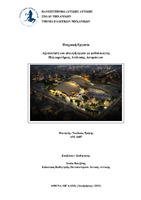| dc.contributor.advisor | Vryzidis, Isaak | |
| dc.contributor.author | Τρίμης, Νικόλαος | |
| dc.date.accessioned | 2022-01-18T11:57:06Z | |
| dc.date.available | 2022-01-18T11:57:06Z | |
| dc.date.issued | 2021-12-17 | |
| dc.identifier.uri | https://polynoe.lib.uniwa.gr/xmlui/handle/11400/1662 | |
| dc.identifier.uri | http://dx.doi.org/10.26265/polynoe-1513 | |
| dc.description.abstract | Ο τομέας της αξιολόγησης και επιλογής έργων έχει αναπτυχτεί σημαντικά τις τελευταίες δεκαετίες. Παρόλα αυτά εξακολουθεί να υπάρχει στο προσκήνιο η συζήτηση για τα ζητήματα εφαρμογής των μεθόδων που οδηγούν στην σωστή αξιολόγηση και επιλογή έργων. Οι απόψεις που έχουν διαμορφωθεί στην επιστημονική κοινότητα, γύρο από το εν λόγο πεδίο ποικίλουν, διότι υπάρχει
διχογνωμία, σχετικά με το ποιο μέγεθος είναι καλύτερο να εφαρμοστή. Προηγούμενες έρευνες, εφαρμόζουν τόσο μεθόδους οικονομικής απόδοσης όσο και μεθόδους επιχειρησιακής έρευνας, όπως είναι η πολυκριτηριακή ανάλυση. Στην παρούσα μελέτη γίνεται αναλυτική παρουσίαση των μεθόδων που έχουν εφαρμοστή, τόσο αυτών της οικονομικής απόδοσης όσο και αυτών της
επιχειρησιακής έρευνας. Προχωρώντας, χρησιμοποιώντας το πρόβλημα απόφασης που έθεσαν οι Valentina Ferretti, Marta Bottero, Giulio Mondini, το οποίο είναι η επιλογή του κτιρίου αυτού που μπορεί να επιφέρει την καλύτερη απόδοση εφόσον επαναχρησιμοποιηθεί για τουριστικούς σκοπούς. Εφαρμόσαμε την δημοφιλέστερη μέθοδο που προέκυψε μέσα από την αρθρογραφική μας έρευνα, η οποία είναι μέθοδο αναλυτικής ιεράρχησης ΑΗP. Συνεχίζοντας, βασιζόμενη στον πολυκριτηριακό πίνακα τον προαναφερθέντων ερευνητών, υπολογίζοντας τα βάρη των κριτήριων με δυο μεθόδους τόσο με αυτή της AHP όσο και με αυτή της WAP. Ολοκληρώνοντας την διαδικασία εφαρμογής της μεθόδου με την κάθε μεθοδολογία βαρών ξεχωριστά, τα αποτελέσματα που προέκυψαν ήταν ιδία για τις δυο πρώτες όπως και την τελευταία επιλογή. Η μόνη διαφοροποίηση όπου υπήρχε ήταν μεταξύ της τρίτης έως και την έκτη εναλλακτική στις οποίες υπήρχε μια ισορροπημένη αντίθεση. | el |
| dc.format.extent | 86 | el |
| dc.language.iso | el | el |
| dc.publisher | Πανεπιστήμιο Δυτικής Αττικής | el |
| dc.rights | Αναφορά Δημιουργού - Μη Εμπορική Χρήση - Παρόμοια Διανομή 4.0 Διεθνές | * |
| dc.rights.uri | https://creativecommons.org/licenses/by-nc-sa/4.0/deed.el | * |
| dc.subject | Διαχείριση έργου | el |
| dc.subject | Project management | el |
| dc.subject | Πολυκριτηριακή ανάλυση | el |
| dc.subject | Multi-criteria analysis | el |
| dc.subject | Αξιολόγηση | el |
| dc.subject | Επιλογή έργων | el |
| dc.subject | Οικονομική απόδοση | el |
| dc.subject | Αναλυτική ιεράρχηση | el |
| dc.subject | Κριτήρια | el |
| dc.title | Αξιολόγηση και επιλογή έργων με μεθοδολογίες Πολυκριτήριας Ανάλυσης Αποφάσεων | el |
| dc.title.alternative | Project evaluation and selection with Multi-Criteria Decision Aid methods | el |
| dc.type | Διπλωματική εργασία | el |
| dc.contributor.committee | Moussas, Vassilios | |
| dc.contributor.committee | Repapis, Constantinos | |
| dc.contributor.faculty | Σχολή Μηχανικών | el |
| dc.contributor.department | Τμήμα Πολιτικών Μηχανικών | el |
| dc.description.abstracttranslated | The field of evaluation and project selection has grown significantly in recent decades. Nevertheless, the discussion on the issues of application of the methods that lead to the correct evaluation and selection of projects is still in the forefront. Opinions that have been formed in the scientific community around this field vary, because there is disagreement about which size is best to apply. Previous research has applied both cost-effectiveness and business research methods, such as multi-criteria analysis. In the present study, a detailed presentation is made of the methods that have been applied, both those of financial performance and those of business research. Going forward, using the decision problem posed by Valentina Ferretti, Marta Bottero, Giulio Mondini,
which is the choice of this building that can bring the best performance if reused for tourism purposes. We applied the most popular method that emerged from our article research which is a method of analytical hierarchy AHP. Continuing, based on the multi-criteria table of the aforementioned researchers, calculating the weights of the criteria with two methods, both AHP and
WAP. Completing the process of applying the method with each weight methodology separately, the results were the same for the first two as well as the last option. The only difference where it existed was between the third to the sixth alternative in which there was a balanced contrast. | el |


